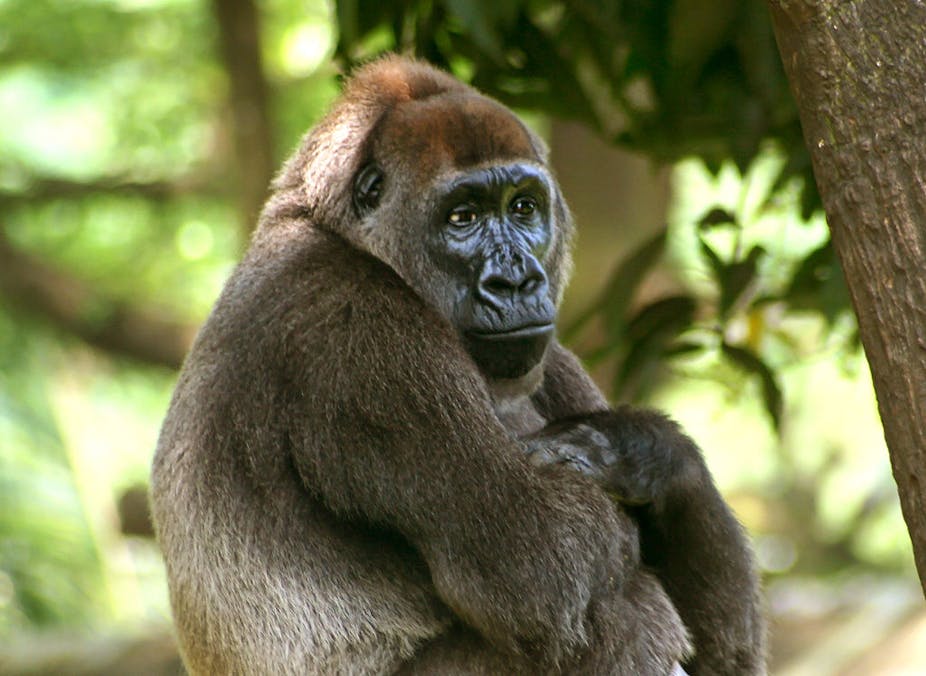In a few densely forested patches of Nigeria and Cameroon there lives a gorilla so rare and so elusive that the best way to study it is through training sniffer dogs to track down its faeces. This is the Cross River gorilla, and there are just 200-300 left in the wild.
To find these shy creatures and learn more about them a team of scientists from Germany and the US turned to detection dogs. They have written about their findings in the Royal Society Open Science journal.
Most of us wish our encounters with faeces to be brief before we flush them away, but this is not the case for conservation biologists. The TV series You Are What You Eat hit on a truth: faecal matter is a rich source of information about its depositors.
Faeces doesn’t just tell us what the owner has been eating – it also contains DNA, gut parasites, and hormones which can tell us about reproduction and stress levels. The researchers in this particular study were after gorilla DNA, which can be used to determine the sex and identity of the individual; this information can then be used to estimate population size, the numbers in a social group, how far the group moves around and how closely related the individuals are.
In the past wild population sizes were estimated by capturing individual animals, marking them and then after some time trying to recapture them. It is possible to estimate population size using data gathered this way, but clearly this method is not appropriate for large and endangered species like gorillas. However, this process can be simulated using the “recapture” of faeces from the same individuals, which is what the scientists did in this study.
Detective doodoo
Gorillas, as you might imagine, create large piles of faeces. But despite their size, finding such deposits in a tropical forest is not an easy task for humans, especially when the gorillas themselves are so shy. One way to overcome this problem is by using specially trained detector dogs to find the gorillas’ faeces (or scats as we biologists call them).
The use of dogs as odour detectors goes back to the 1960s when they were first exploited to detect narcotics, and these days their olfactory abilities are employed to sniff out everything from explosives to cancerous tumours to the floating poop of killer whales.
Scientists still debate how good a dog’s sense of smell is. But research shows that they can detect chemicals in parts per trillion, whereas most chemical sensing machines work in parts per billion. Dogs possess 20 times as many olfactory receptors as humans, and they dedicate 40 times more of their brain to processing smells. It is said that if their smell was taste they could detect a teaspoon of sugar in the amount of water needed to fill two Olympic swimming pools. They also can detect all the separate components of a smell; their nose can determine the ingredients list of whatever they are sniffing.

Moths and bees can also be trained to detect explosives or drugs, while African pouched rats can detect landmines and even tuberculosis better than humans with machines. The advantage dogs have over insects and to an extent rats is their ability to cover large areas in short periods of time. But as with all detection animals the problem is the need for a human handler who often slows the dog down, especially in a mountainous tropical forest.
Africa needs its own dog detectives
The dogs used in this study were Working Dogs for Conservation flown in from the US . They proved more successful at finding scats than human fieldworkers and they were less biased in site location. Where human fieldworkers tended to look for gorilla nests and then procure scats nearby, dogs would instead scan the whole area. This meant the dogs found scats belonging to more individual gorillas, which in turn bumped up the estimated population size. Given sufficient field time the authors believe detection dogs would provide a precise estimate of gorilla population size.
However, specially trained dogs and handlers imported from the US meant the cost per scat found was seven times more expensive than those found by human fieldworkers. This pilot study of just a few weeks cost nearly US$100,000.
The authors of this study recognise, despite the cost, the value of using detector dogs in longer term studies of highly endangered species such as Cross River gorillas, especially if dogs are simultaneously searching for scats of several endangered species. And they suggest the establishment of a local detection dog program. Gorilla-hunting sniffer dogs for Africa? It’s a novel cause – but a worthy one.

